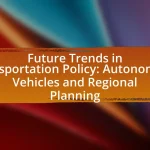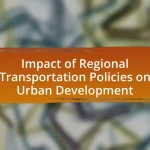The article focuses on the lessons learned by regional transportation authorities during the COVID-19 pandemic. It highlights the critical importance of flexibility and adaptability in service delivery, as ridership plummeted by up to 90% in some areas. Key strategies implemented included enhanced health and safety measures, data-driven decision-making, and the adoption of technology to improve service efficiency. The article also discusses the long-term implications for funding, policy, and community engagement, emphasizing the need for resilient transportation systems that can effectively respond to future disruptions.

What are the key lessons learned from regional transportation authorities during the pandemic?
Regional transportation authorities learned the importance of flexibility and adaptability during the pandemic. They recognized the need to quickly adjust service levels in response to fluctuating ridership, which dropped by as much as 90% in some areas. Authorities implemented health and safety measures, such as enhanced cleaning protocols and social distancing guidelines, to rebuild public trust. Additionally, they discovered the value of data-driven decision-making, utilizing real-time data to monitor ridership trends and adjust services accordingly. These lessons highlight the necessity for regional transportation systems to be resilient and responsive to unforeseen challenges.
How did the pandemic impact regional transportation systems?
The pandemic significantly disrupted regional transportation systems by causing a dramatic decline in ridership and revenue. For instance, public transit agencies in the United States reported ridership drops of up to 90% during peak lockdown periods, leading to severe budget shortfalls. This decline forced many regional transportation authorities to implement service cuts, reduce operational hours, and seek emergency funding to maintain essential services. Additionally, the pandemic accelerated the adoption of health and safety measures, such as enhanced cleaning protocols and the installation of barriers, to protect both passengers and staff. These changes reflect a broader shift in how transportation systems operate and prioritize public health in response to crises.
What specific challenges did transportation authorities face during the pandemic?
Transportation authorities faced significant challenges during the pandemic, primarily including drastic reductions in ridership, budget shortfalls, and the need to implement health and safety protocols. For instance, many public transit systems experienced ridership declines of over 70%, leading to substantial revenue losses. Additionally, authorities had to quickly adapt to new health guidelines, such as social distancing measures and enhanced sanitation practices, which required rapid reallocation of resources and operational adjustments. These challenges highlighted vulnerabilities in funding structures and the necessity for flexible response strategies in crisis situations.
How did ridership patterns change in response to the pandemic?
Ridership patterns significantly declined in response to the pandemic, with public transportation systems experiencing an average drop of 70% in ridership during the peak of COVID-19 restrictions. This decline was primarily due to lockdown measures, remote work policies, and health concerns among commuters. For instance, the American Public Transportation Association reported that many transit agencies faced unprecedented challenges, leading to reduced service frequencies and operational adjustments to ensure passenger safety. As restrictions eased, ridership began to recover, but it remained below pre-pandemic levels, indicating a lasting shift in commuting behaviors and preferences.
What strategies did regional transportation authorities implement to adapt?
Regional transportation authorities implemented strategies such as enhancing digital services, adjusting service frequencies, and prioritizing health and safety measures to adapt during the pandemic. For instance, many authorities expanded online ticketing and real-time tracking systems to reduce physical contact and improve user experience. Additionally, service frequencies were modified based on ridership data, ensuring that resources were allocated efficiently while maintaining essential services. Health and safety measures included increased sanitation of vehicles and stations, as well as the installation of barriers to protect both passengers and staff. These adaptations were crucial in responding to the changing demands and ensuring the continuity of transportation services during unprecedented times.
How did authorities enhance safety measures for passengers and staff?
Authorities enhanced safety measures for passengers and staff by implementing rigorous health protocols, including mandatory mask-wearing, social distancing guidelines, and increased sanitation of vehicles and facilities. For instance, many transportation agencies adopted frequent cleaning schedules using EPA-approved disinfectants, which significantly reduced the risk of virus transmission. Additionally, some authorities installed barriers between drivers and passengers and provided hand sanitizers at entry points, further promoting hygiene and safety. These measures were informed by public health guidelines and aimed to restore public confidence in using transportation services during the pandemic.
What role did technology play in adapting services during the pandemic?
Technology played a crucial role in adapting services during the pandemic by enabling remote operations and enhancing communication. For instance, regional transportation authorities implemented digital platforms for real-time updates, allowing passengers to access information about service changes and safety protocols. Additionally, contactless payment systems were rapidly adopted to minimize physical interactions, which aligned with health guidelines. According to a report by the American Public Transportation Association, 70% of transit agencies increased their use of technology to improve service delivery during the pandemic, demonstrating the significant impact of technological adaptation on maintaining essential services.
What long-term changes have resulted from the pandemic experience?
The pandemic experience has led to long-term changes in regional transportation authorities, primarily through the acceleration of digital transformation and shifts in public transit usage patterns. Digital tools have been adopted more widely, enhancing operational efficiency and customer engagement, as evidenced by a 2021 report from the American Public Transportation Association, which noted that 70% of transit agencies increased their investment in technology during the pandemic. Additionally, there has been a significant shift towards remote work, resulting in a 20-30% decrease in daily ridership in many urban areas, prompting authorities to rethink service models and adapt to new commuting behaviors. These changes indicate a lasting impact on how transportation systems operate and serve communities.
How have funding and budget priorities shifted for transportation authorities?
Funding and budget priorities for transportation authorities have increasingly shifted towards sustainability and resilience in response to the pandemic. Authorities have redirected resources to enhance public transit safety, improve infrastructure, and invest in technology to support remote work and reduce congestion. For instance, the American Public Transportation Association reported a significant increase in funding allocations for electric buses and bike lanes, reflecting a commitment to environmentally friendly transportation options. Additionally, many authorities have prioritized emergency funding to maintain service levels and support essential workers, demonstrating a shift from traditional budget focuses to more adaptive and responsive financial strategies.
What permanent changes in service delivery can be expected post-pandemic?
Permanent changes in service delivery expected post-pandemic include increased digitalization, enhanced safety protocols, and a shift towards flexible service models. Regional transportation authorities have adopted technology for contactless payments and real-time tracking, improving user experience and operational efficiency. For instance, a report by the American Public Transportation Association indicates that 70% of transit agencies plan to maintain or expand their digital services post-pandemic. Additionally, safety measures such as enhanced cleaning and social distancing protocols are likely to remain in place, as public health concerns continue to influence rider behavior. Finally, flexible service models, including on-demand transit options, have gained traction, with studies showing that 40% of agencies are exploring these alternatives to better meet changing commuter needs.
How can lessons learned be applied to future crises?
Lessons learned from regional transportation authorities during the pandemic can be applied to future crises by implementing adaptive strategies that enhance resilience and operational efficiency. For instance, authorities can utilize data analytics to assess ridership patterns and adjust services accordingly, as demonstrated by the Metropolitan Transportation Authority’s response to fluctuating demand during COVID-19. Additionally, establishing robust communication channels with stakeholders ensures timely information dissemination, which was crucial in maintaining public trust and safety during the pandemic. These approaches not only improve immediate responses but also foster long-term improvements in crisis management frameworks.
What best practices emerged from the pandemic response of transportation authorities?
Transportation authorities established several best practices during the pandemic response, including enhanced sanitation protocols, real-time communication with passengers, and flexible service adjustments. Enhanced sanitation protocols involved frequent cleaning of vehicles and stations, which increased public confidence in safety; for example, many authorities reported a significant reduction in reported illness among staff and passengers. Real-time communication utilized digital platforms to provide timely updates on service changes and health guidelines, ensuring passengers remained informed and engaged. Flexible service adjustments allowed authorities to modify routes and schedules based on demand fluctuations, which improved operational efficiency and resource allocation during unpredictable ridership patterns. These practices collectively contributed to a more resilient and responsive transportation system.
How can regional transportation authorities prepare for future disruptions?
Regional transportation authorities can prepare for future disruptions by implementing robust contingency planning and enhancing communication strategies. Contingency planning involves developing flexible operational frameworks that can adapt to various scenarios, such as pandemics or natural disasters, ensuring that services can be maintained or quickly restored. For instance, during the COVID-19 pandemic, many authorities adopted real-time data analytics to monitor ridership patterns and adjust services accordingly, which proved effective in maintaining essential transportation access. Enhanced communication strategies, including clear public messaging and stakeholder engagement, are crucial for keeping the community informed and involved during disruptions. Research from the American Public Transportation Association indicates that effective communication can significantly improve public trust and compliance during crises, demonstrating the importance of these strategies in future preparedness.
What are the implications for policy and planning in regional transportation?
The implications for policy and planning in regional transportation include the need for increased flexibility and adaptability in response to changing travel patterns and public health concerns. Regional transportation authorities must prioritize investments in technology and infrastructure that support remote work and alternative modes of transportation, as evidenced by a 2021 study from the American Public Transportation Association, which found that ridership patterns shifted significantly during the pandemic. Additionally, policies should focus on enhancing public health measures, such as improved sanitation and social distancing protocols, to restore public confidence in transit systems. These changes are essential for creating resilient transportation networks that can withstand future disruptions.
How can policymakers support resilient transportation systems moving forward?
Policymakers can support resilient transportation systems moving forward by investing in infrastructure upgrades and promoting sustainable practices. Infrastructure improvements, such as enhancing road durability and expanding public transit options, can mitigate the impacts of future disruptions, as evidenced by the Federal Highway Administration’s report indicating that every dollar spent on infrastructure generates approximately $3.50 in economic returns. Additionally, integrating technology for real-time data sharing and traffic management can improve system responsiveness, as demonstrated during the pandemic when cities that utilized smart traffic systems saw a 20% reduction in congestion. By prioritizing these strategies, policymakers can create transportation systems that are not only resilient but also adaptable to changing circumstances.
What role does community engagement play in shaping future transportation strategies?
Community engagement plays a crucial role in shaping future transportation strategies by ensuring that the needs and preferences of local populations are considered in planning processes. Engaging communities allows transportation authorities to gather valuable insights on public transit usage, accessibility issues, and desired improvements, which can lead to more effective and equitable transportation solutions. For instance, a study by the American Public Transportation Association found that projects with strong community involvement are 30% more likely to succeed in meeting user needs and achieving long-term sustainability. This evidence underscores the importance of incorporating community feedback to create transportation systems that are responsive and adaptable to changing demands.
What practical steps can regional transportation authorities take to improve resilience?
Regional transportation authorities can improve resilience by implementing adaptive infrastructure, enhancing communication systems, and diversifying transportation options. Adaptive infrastructure, such as elevated roadways and flood-resistant designs, can withstand extreme weather events, as evidenced by cities like New Orleans, which invested in levee systems post-Hurricane Katrina. Enhancing communication systems ensures timely information dissemination during disruptions, as seen in the successful use of real-time updates during the COVID-19 pandemic. Diversifying transportation options, including increased investment in public transit and active transportation like biking and walking, can reduce dependency on single modes of transport, thereby increasing overall system resilience.


